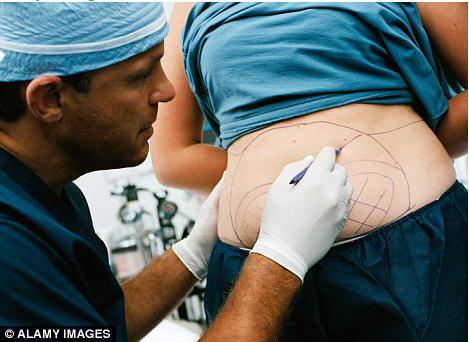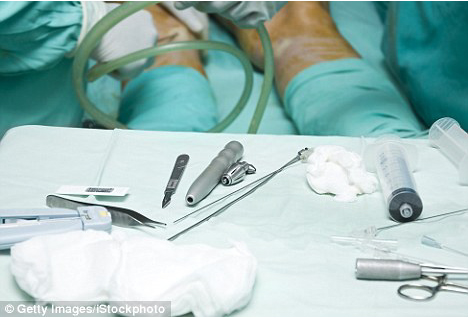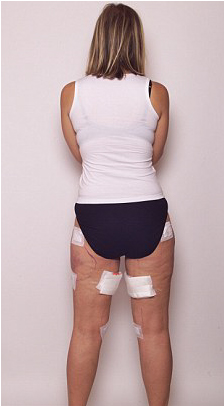Liposuction fat is back within a year: What's taken from thighs 'returns on arms'
Back to browse - View full topic
Liposuction carries the unwanted side-effect of making other parts of a patient's body fatter, a study has found. One year after having liters of fat removed, those undergoing the procedure will effectively be back at square one in terms of the amount of fat in their body. However, the fat will not return to the areas of the body where it was removed from, usually the thighs, lower abdomen and buttocks.

You Can't Fool Nature: A new study finds that fat removed by liposuction comes back within a year, though not in the same place
Instead it will reappear elsewhere, typically around the shoulders, arms and upper abdomen, according to U.S. researchers.
Liposuction is a simple but crude surgical process involving the insertion of a tube under the skin attached to a powerful vacuum pump which literally sucks the fat out of chosen areas of the body.
After bruising and swelling from the operation has healed, the areas treated visibly shrink to achieve what months of dieting has failed to do.
Last year there were 3,369 liposuction operations carried out in the UK by members of the British Association of Aesthetic Plastic Surgeons.
The procedure, which usually costs up to £5,000, has boomed in popularity in recent years.
But the latest findings could be a serious blow to its popularity.
The study involved 32 non-obese and healthy women of average weight and aged in their mid-30s.
While 14 were randomly selected to have a modest amount of fat removed by liposuction from their hips and thighs, the remaining 18 acted as ‘controls' who did not have the procedure.

Tools of the trade: About 450,000 liposuctions are performed every year, at a cost of several thousand dollars a pop. But it might not be effective in the long term
All the women agreed not to undergo 'lifestyle changes' while the research was being conducted. http://www.meandmybody.com/obesity
Measurements of all the women were carried out at six weeks, six months and a year, to monitor the distribution of fat.
After six weeks the treated patients had lost 2.1 per cent of their fat, compared with 0.28 per cent in the control group, but this difference had disappeared at one year to the point where it was 'no longer significant'.
The fat did not return to the same place, but in general was 'redistributed from the thigh to the abdomen'.
However, the findings were not regarded negatively by many of the women involved.
The women who underwent liposuction were happy that fat had been removed permanently from their hated hips and thighs, even at the expense of transferring the fat elsewhere.
And more than half in the 'control' group still decided to go ahead with planned procedures – which they had earlier been promised at reduced cost at the end of the study.
Cut celebs: Tara Reid and Kathy Griffin are well-known devotees of liposuction



Men and women: Although researchers targeted women in their study, men get liposuction too, including Dwayne 'The Rock' Johnson, who had it in the chest
The study was led by Teri Hernandez and Robert Eckel of the University of Colorado.
Commenting on the results, Dr Eckel said fat 'was redistributed upstairs', mostly in the upper abdomen, but also around the shoulders and triceps of the arms. Tests previously carried out in the laboratory on rats have shown similar results.
Analyzing the results, Rudolph Leibel, an obesity researcher at New York's Columbia University, said that liposuction surgically destroys the structure under the skin, which may be why the fat cells don't grow back in the place from which they were removed.
Instead the body compensates for their swift loss by growing new fat cells in other areas.
'It's another chapter in the “You can't fool Mother Nature” story,' Dr Leibel said. (Only up to a point. Mother Nature is not so easily fooled).
Liposuction techniques were developed during the 1970s and have been popular in the United States for 30 years.
About 450,000 liposuction operations are carried out annually there.
Fat cells in humans die and new ones are born throughout life.
Scientists have found that fat cells live for only about seven years and that every time a fat cell dies, another is formed to take its place.
The best solution is the obvious one – With a minimal amount of discipline, one can avoid the trials and costs of surgical procedures.
In addition, we believe that one of the conditions for long-term positive affects after a liposuction procedure is the need to start and maintain a regular exercise program.
So why not program for that at the outset, discipline your eating habits and you will be sure to lose excess fat and live a healthy life the natural and correct way.
Start Today! We will assist wherever possible.